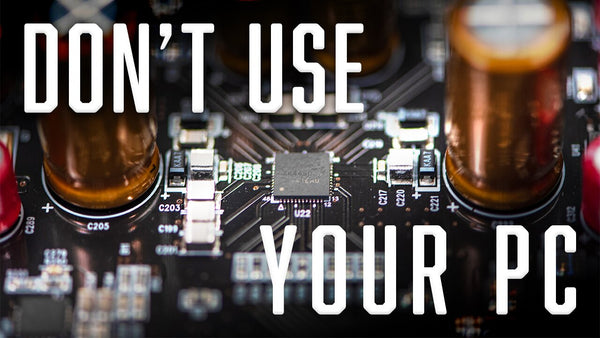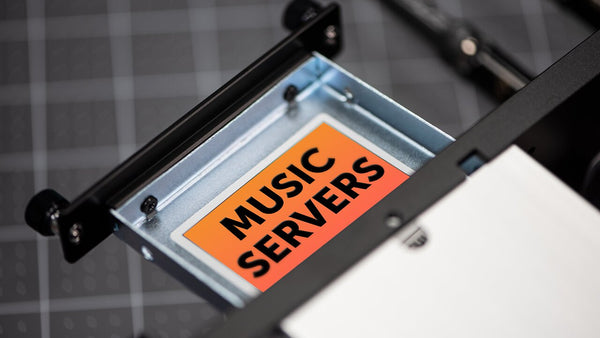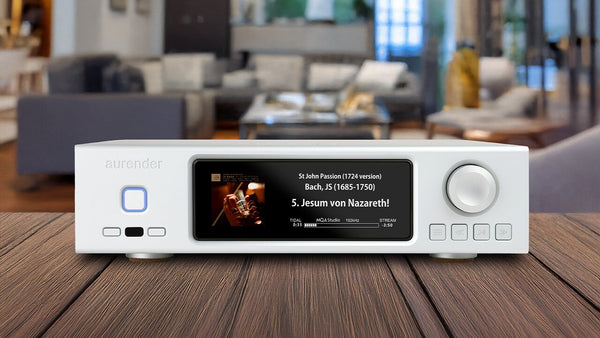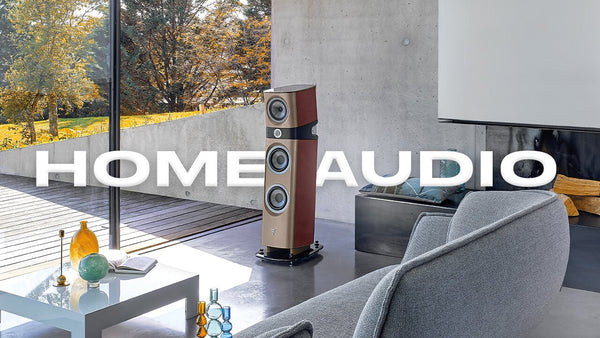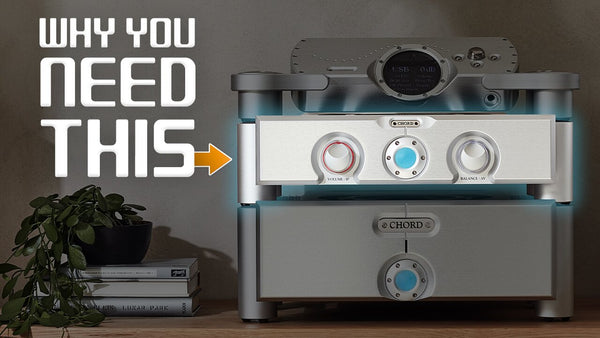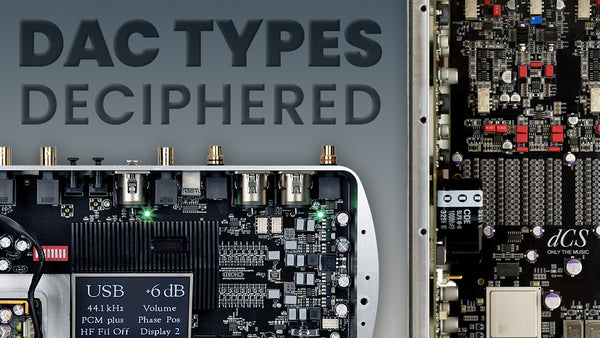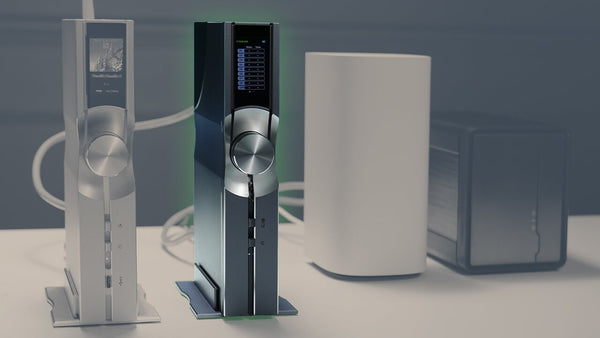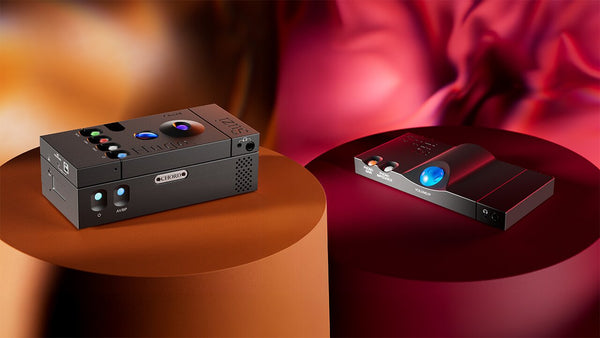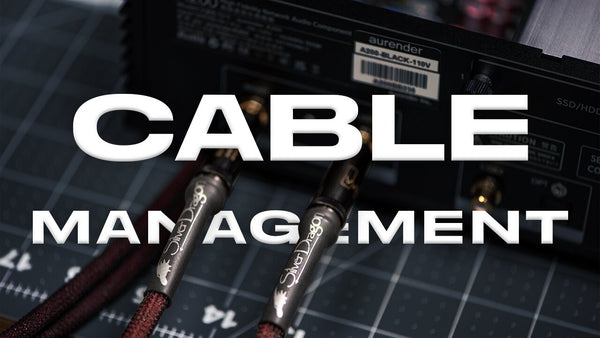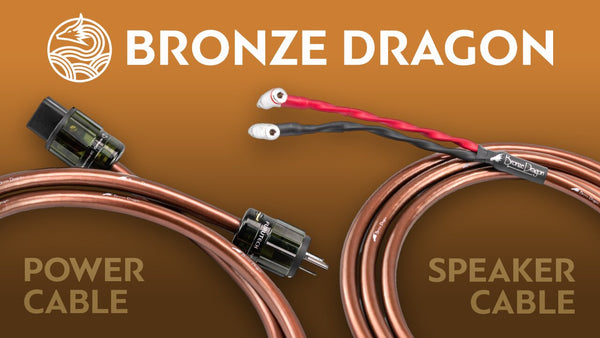3 Reasons to Buy a Music Streamer

Your Guide to Selecting the Perfect Music Streamer
You've decided to join the legions of hi-fi streaming enthusiasts, and you might be wondering whether you should purchase a dedicated music streamer. The simple fact is, you don't need a particular piece of hardware to stream music. All you need is an internet connection and a phone or computer. But that may not be doing justice to your streaming experience or to your audiophile ears.
When it comes down to it, a music streamer is the way to go. Whether it's digital audio files that you’ve ripped from your CD collection or high-res content that you stream from music services, you'll enjoy a higher quality of audio and a better user experience. Before we go any further, however, let's clarify what we mean by music streamer.
Simply put, a streamer is a piece of hardware that allows you to access and play music via a network or internet connection. This can mean music from a streaming service such as Spotify or TIDAL, or from locally stored music files. Technically, your phone is a music streamer, as it's a conduit for streaming music. You can download a streaming service onto your phone, buy a subscription if necessary, and start listening. What we're talking about when we say a music streamer is an audio device that's specifically designed and optimized for streaming music. This could be a device with or without a DAC (digital-to-analog converter), and with or without storage. With storage, it's called a streaming server. Without internal storage, of course, a streamer can pull music from a NAS (network-attached storage) or external hard drive.
Let's take a look at how a music streamer or streaming server device can elevate and enhance your listening experience, and which one you should choose for your setup.
3 Reasons to Buy a Music Streamer
Why Should I Get a Music Streamer?
1. All-In-One User-Friendly Solution
Maybe you own a ton of hi-res audio files but you’ve got no good way to manage them. If you're looking for a streamlined, user-friendly solution, then a streamer is for you. A great thing about a streaming device is that it puts a world of music at your fingertips, with your streamed content and personal music library all in the same place. These devices are specifically and solely designed for music database management.
Now you only need one piece of software to control your streamed content as well as your stored files. With your computer, you may have had separate software for multiple streaming services; now it's all controlled with one mobile app via your iPhone, iPad, or Android device. Now you can just sit back, push a few buttons, and grow roots on your couch. OK, we don't suggest doing that. But you can't beat the convenience factor.
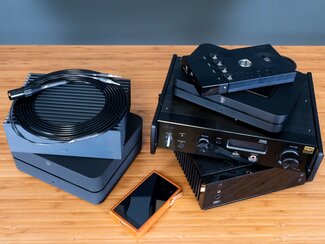
Software will vary between streamers. The Aurender Conductor app, for example, is easy to use, but only offers TIDAL and Qobuz. The BluOS app for Bluesound is chock full of options, but the software isn't as user-friendly. However, if you don't like the software with your streamer — maybe it's difficult to navigate or it's too techy — you can always use Roon music management software. Most of the brands that we sell, excluding Aurender, are Roon Ready, meaning they have compatibility with Roon.
Roon is like Wikipedia for music, putting a candy store of metadata at your fingertips. There is no right answer here; you have to decide what's best for your scenario. Just know that while browsing an app won't replace the tactile pleasure of handling album sleeves or liner notes, it can provide you with a visually pleasurable way of perusing your collection and streamed content as well as creating playlists and discovering new music.
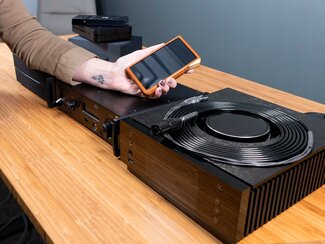
2. Sound Quality
As previously stated, you can stream hi-res music from your computer, phone, or tablet and do just fine. Is it going to sound optimal? Likely not. A streamer is specifically designed to handle audio files in a way those other devices aren't. At the end of the day, a computer does a lot of things well, but it wasn't designed as an audio playback device. Computers are noisy; they weren't designed to be quiet from a sonic level but also from an electric standpoint. Is there a night and day difference between a computer and a streamer? Probably not. Is there a difference? Definitely. And if you're trying to squeeze out every last percentage point of performance, a streamer is the way to go.
Streamers vary in the types of files they can play, from CD quality up to 384 kHz or newer formats. When you're looking to play locally stored lossless files or access hi-res tracks from a music subscription service, you'll want to make sure that your streamer of choice supports the files types you want.
Whether or not your streamer includes a DAC, you may opt to use an external one. If you happen to own a high-end DAC, it may well be better than the one in your streamer; that's for you to determine. In our opinion, the DAC will account for about 70% of the sound quality, with the streamer accounting for the other 30%. So spend more money on your DAC (if you're buying one). But know that both are important.
There is an argument to be made that the files that you purchase from a hi-res download site may have a better sound than some of the streaming services because there is influence of the streaming service's algorithms and how they change the sound quality of the stream. So if you're locally storing your own bit-perfect files that you've purchased, there is a potential for the recording to sound better. If you're a critical listener, maybe you want to own some specific, critical hi-res downloads and then stream some other stuff.
3. Take Your Phone or Computer Out of the Playback Equation
When you use your phone or laptop as a streamer, that device is multitasking. Someone calls while you're listening to music? That can be a very unwelcome interruption. Laptop battery dies mid-song? Not cool. When you use a mobile device or computer for streaming, that device needs to be powered on, and it needs to be nearby. Essentially, you are tethered to that device. Using a dedicated streamer takes your device out of the equation -- at least as a playback vehicle; you will still be using your device to control the software on your streamer. One more benefit: A streamer with storage means you won’t be storing audio files on your computer.
Which Music Streamer is Right for Me?
With the popularity of music streaming having exploded among audiophiles in recent years, there are hordes of hi-fi music streamer options out there. To narrow down your choices, it helps to think about the functionality that you desire. Two primary considerations are:
Do you need a DAC? Many of today's streamers have an on-board DAC to handle digital-to-analog conversion. However, if you already own a DAC that you like, there's no need to purchase a streamer with a DAC. If you do purchase a streamer with a DAC, and you prefer to use your own, then you can always bypass the DAC in your streamer.
Do you need storage for digital files? This is a must if you've got digital audio files and you don't want to store them on your computer. Many streamers either come with internal hard drives or the option for adding storage, either an add-on hard-drive, USB storage or networked attached storage (NAS). When a streamer includes storage, we refer to it as a streamer/server. As a rule of thumb, internal storage will sound better than add-on storage. Now, if you plan to stream high-resolution content exclusively from music streaming services like TIDAL and Qobuz, then you don't need internal storage.
Another thing to consider when purchasing a streamer is the control app you will be using to manage your music library and music playback. Many streamers come with their own software, whether it be Matrix's MA Remote, Bluesound's BluOS, or Aurender's Conductor. Each software has its advantages and disadvantages when it comes to features and usability. But on top of a manufacturer's own software, many brands are compatible with Roon music streaming software. Roon is a subscription music management software that manages your music files, streaming services, and your audio devices. One thing people love about Roon is that it's like a "Wikipedia" for music, with lots of rich metadata including artist bios, music suggestions, and much, much more. If you wish to use Roon, then you want to be sure your streaming device is Roon Ready. All of the brands listed below are Roon Ready except for Aurender, which is a "closed" ecosystem and is not compatible with Roon. That being said, the Aurender Conductor App is a wonderful and easy-to-use app that some people prefer over Roon. It all comes down to personal preference.
I Want a Music Streamer and I Already Own a DAC
A DAC is essential for listening to digital music, since you need something that will convert the digital signals back to analog. But if you already own a DAC that you like, then there's no need to purchase a streamer with a DAC. Here are some options for high-quality streamers that don't include DACs.
Aurender N20 Streaming Music Server
The Aurender N20 provides the fidelity, features, and flexibility the digital audiophile will find attractive and meaningful. A significant advantage is that the N20 contains two empty storage bays. This allows you to customize storage to best meet your budget and intended use. For example, these days many music lovers listen exclusively to streaming content. Therefore, no internal storage is necessary (although it can be easily added at any time if desired). Have a modestly sized music collection? Install an inexpensive 2TB HDD. Own a massive music library? Opt-in for 2 SSDs or HDDs. Fully loaded, the N20 is capable of accommodating an incredible 16TB of solid-state storage! The N20 is available in silver or black and features an 8.8-inch IPS LCD display.
Dragon Cable Recommendation: We recommend pairing the Aurender N20 Music Server/ Streamer with our Black Dragon Power Cable, Silver Dragon Network Cable, and Silver Dragon USB Cable (USB A to C).
Aurender ACS10 Music Server with CD Ripper
The Aurender ACS10 is designed to be your one-stop solution for digital music management. A caching music server with a CD ripper, content storage, library management, and meta-tag editor, it has everything an audiophile needs when using a file-based playback system, designed to simplify the tasks at hand. It can be used as a companion to your existing Aurender Music Server to expand its function and flexibility or as a fully functional server and streamer on its own. File storage - up to 24TB - is on dual 3.5” HDDs. The ACS10 is available in silver or black and features a 4-inch IPS LCD display.
Dragon Cable Recommendation: We recommend pairing the Aurender ACS10 Music Server/CD Ripper with our Black Dragon Power Cable, Silver Dragon Network Cable, and Silver Dragon USB Cable (USB A to C).
iFi Audio ZEN Stream
The iFi Zen Stream is the easiest (and best) way to get into high-resolution music streaming. It does streaming from all your favorite services, NAA, DLNA streaming, it's Roon Ready, and basically, all you need to do is connect your source and you're good to go! It's compatible with Tidal and Spotify Connect, has integrated AirPlay, and incorporates active noise cancellation and their iPurifier technology into the little streamer too. The Zen is a great size too, being about the size of a 3.5-inch internal hard drive, you can easily place this just about anywhere with options for Ethernet or wireless connections. The I/O selection in the back is also sufficient for connecting external storage, outputting to DAC via USB, coax, etc, for a great affordable and high-quality first step into a larger world of high-resolution music streaming.
Dragon Cable Recommendation: Black Dragon USB Cable
I Want a Music Streamer with a DAC
If you don't own a DAC, you will want to purchase a streamer that has a DAC built in.
dCS LINA Network DAC
The LINA DAC is a giant in a small box. It features dCS' patented Ring DAC system, digital processing platform, and Expanse technology. It's fully balanced, compatible with all digital audio formats, and Roon Ready. The entirely smooth front panel features dCS' first touchscreen UI with a customizable menu that allows listeners to easily control playback and adjust system settings. The display screen is a little under 2 x 3 inches. Underneath are four lighted buttons; these are what you press, not the icons on the screen. Now, you might opt to forgo this entirely and just use the dCS Mosaic Control app for iOS or Android to control your system. You can't go wrong either way. Pair the LINA DAC with the LINA Headphone Amplifier and Master Clock for a high-end trio that will knock your socks off.
Dragon Cable Recommendation: Silver Dragon Premium Interconnect Cable, Silver Dragon Network Cable, Silver Dragon Coax Digital Cable, Silver Dragon USB Cable.
Matrix Audio X-Sabre 3 MQA DAC
The X-Sabre 3 is a sleek and slim Roon-Ready device that functions as a network capable streaming host. It doesn't come with internal storage, but you can use Roon to stream from a NAS and streaming services. The X-Sabre 3 Pro has a built-in preamp. In addition to decoding the MQA audio stream up to 24 Bit 384kHz, the -Sabre 3 Pro can support DSD1024 and PCM audio stream up to 32Bit/768kHz sampling rate. It also comes pre-installed seven kinds of PCM digital filter options. The X-Sabre is available in black or silver and features s small circular color LCD screen.
iFi Audio NEO Stream Music Streaming Player
The X-Sabre 3 is a sleek and slim Roon-Ready device that functions as a network capable streaming host. It doesn't come with internal storage, but you can use Roon to stream from a NAS and streaming services. The X-Sabre 3 Pro has a built-in preamp. In addition to decoding the MQA audio stream up to 24 Bit 384kHz, the -Sabre 3 Pro can support DSD1024 and PCM audio stream up to 32Bit/768kHz sampling rate. It also comes pre-installed seven kinds of PCM digital filter options. The X-Sabre is available in black or silver and features s small circular color LCD screen.
Bluesound NODE ICON Reference Music Streamer
Bluesound's newest music streamer the NODE ICON is the perfect unit for novices and seasoned vets. With full streaming capabilities, access to over 20 streaming services via the dedicated BluOS Controller App, and multi-room playback capabilities, the NODE ICON is a force to be reckoned with. For the price, the NODE ICON offers tremendous value and its user interface is so easy to navigate that you'll have no problems setting the unit up and enjoying your favorite tunes.
All of Bluesound's products are incredibly intuitive and reasonably priced. Whether you're new to music streaming or looking to add another streamer to your collection, the NODE ICON and the entire NODE series of products will not disappoint.
Dragon Cable Recommendation: Our Black Dragon Mini Coax Cable is an extremely flexible cable, making it a perfect match for home audio digital transmission applications. The Silver Dragon Toslink Digital Cable has the bandwidth to deliver up to 24-bit/192kHz resolution and DSD signals for hi-fi listening sessions.
I Want a Music Streamer with Storage and I Don't Need a DAC
If you plan to stream music exclusively from services like TIDAL and Qobuz, you don't need file storage. However, if you have a digital music collection, you will need somewhere to put those files. This can be an internal hard drive, USB storage, or network attached storage (NAS). The Aurender N10, for example, comes with 4TB of internal storage. The Aurender A30, on the other hand, offers user-installable storage in the form of a sliding tray to accommodate SSD or HHD. And all Aurender models allow the user to add external USB hard drives or networking storage.
Aurender N150 Music Player and Server
The Aurender N150 is a compact component incorporating everything needed to browse and stream hi-res music from Tidal, Qobuz, Spotify or internet radio using Aurender's dedicated application, Aurender Conductor. Should you wish to add digital files to the N150, there’s a provision to add a single 2TB or 4TB HDD or an 1TB, 2TB, 4TB, 8TB SSD in order to fully accommodate the size of your file library. And, if you’re streaming 100%, hard drives are totally unnecessary! And the N150 handles virtually any file format. From its “clean” Audio Class 2.0 USB output file resolutions supported include 32-bit / 384kHz, 1-bit, 2.8MHz (DSD64); 1-bit, 5.6MHz (DSD128), 11.2MHz (DSD256) and DSD512. Updated and improved upon by virtue of an all-new dual-core processor, low-noise linear power supply and increased system memory brings higher fidelity to your digital files and streams. The N150 is available in black or white and features a 3-inch AMOLED display.
Dragon Cable Recommendation: We recommend pairing the Aurender N150 Music Player and Server with our Black Dragon Power Cable, Silver Dragon Network Cable, and Silver Dragon USB Cable (USB A to C).
I Want a Music Streamer with Storage and a DAC
This is the place to be if you need a streamer that has storage and a DAC.
Aurender A20 Music Server
The A20 shares the same basic circuitry topologies and form factor as the flagship A30. However, it dispenses with the CD ripping functionality, metadata editing software and the headphone connection provided is a single standard ¼” jack. What distinguishes the A20 from other analog output models is its pure audio performance. Employing the world-renown AKM 4497 chipset in a dual-mono with dual linear power supplies, you can expect nothing but the best in sound quality. Also included is full MQA Decoder technology which enables you to play back full-resolution MQA audio files and streams, delivering the highest possible sound quality of the original master recording. Since many audiophiles will use the A20 as their “digital hub,” the ability to reduce system complexity is easily achieved. For example, the A20 can function as a preamplifier, allowing for direct connection to a stereo power amplifier or active speaker system. The preamp section has both SPDIF and optical inputs that allow other source components like a CD transport, Blu-Ray player or cable box to feed its audio through the A20’s DAC improving fidelity. Lastly, the system volume can be controlled three ways; the front panel rotary control, the Aurender Conductor app or using the supplied IR remote control.
Dragon Cable Recommendation: We recommend pairing the Aurender A20 Music Server/Streamer with our Silver Dragon Network Cable, Silver Dragon Interconnect Cable (XLR and RCA), and Silver Dragon USB Cable (USB A to B).
Bryston BDA 3.14 Streaming DAC
With the BDA-3.14, Bryston merged its BDP and BDA platforms into this one new product that starts with the BDA-3 and adds a high-quality streamer internally connected with I2S - the most accurate digital interconnection method currently available. Additionally, 10 other inputs are available to make the BDA-3.14 your high-resolution digital hub. The BDA-3.14 offers streaming capability via a built-in music player that delivers access to network-connected storage and USB drives as well as streaming services such as Qobuz, Tidal, Roon and Internet radio. Digital connectivity between the internal music player and the DAC is managed using the I2S protocol, a premium interface standard used for connecting digital audio devices together that preserves audio and clock data with virtually zero error. The BDA-3.14 also features a digital volume control, enabling users to drive an amplifier directly. An updated version of Bryston’s Manic Moose user interface for phones, tablets and computers provides users with intuitive control overall functionality.
Dragon Cable Recommendation: We recommend pairing the Bryston BDA-3.14 Streaming DAC with our popular Silver Dragon Interconnect.
Bluesound Vault 2i Network Streamer
Do you need CD ripping plus storage for all of those digital files? The Bluesound Vault 2i Network Streamer, priced at $1,399, has a built-in ripper and 2TB of internal storage. Featuring a 32-bit, 192 kHz DAC, the Vault 2i has a detailed and resolute sound. At just over 4 pounds and measuring about 8.7 x 3.5 x 7.5 inches, the Vault is beautifully compact. On the top of the unit is your touchscreen, and it’s got this cool feature where waving your hand will light up the screen. The front of the unit features a single 3.5mm stereo headphone jack. As for CD ripping, it couldn’t be easier: It happens automatically when you insert a disc, and your digital files are saved in FLAC format.
Dragon Cable Recommendation:
- Audio Output: Blue Dragon Interconnect Cable
- USB Ports: Black Dragon USB Cable
- Analog Output: Blue Dragon Portable Mini Cable
- Optical Input: Silver Dragon Toslink Digital Cable (Mini Toslink option)
- Optical Output: Silver Dragon Toslink Digital Cable
- Coaxial Output: Black Dragon Mini Coax Digital Cable
Matrix Audio Element i2 Streaming Music Player (add external hard drive)
The Element i2 is the entry-level model of the Element music streamers, but it is equipped with the same quad-core CPU and digital audio interface chip as the higher-priced models. The powerful processing ability enables the Element i2 to process various sampling rates audio files effortlessly. It's also an MQA full decoder. The second-generation streamer is equipped with a 3.46-inch LCD touch screen, allowing you to view track information as well as control playback (which can also be done with the included remote control or through the MA Remote App). Wiht MA Remote, you can browse and play back your local music files (connect an external hard drive for storage), online music stream from TIDAL and Qobuz, and even Internet radio stations. Device configurations and firmware updates also can be managed by the app. Matrix Audio added a 4.4 mm balanced headphone jack to the Element i2, making it convenient to pair with various headphones. The built-in headphone amplifier has been upgraded to a 4-channel full-balanced architecture. The fully symmetrical circuit design allows the left and right channel signals to pass through a nearly perfectly symmetrical amplification circuitry.
Dragon Cable Recommendation: The Silver Dragon USB Cable is our best-selling cable at Moon Audio and the perfect companion for the Matrix Audio Element i2.
Related Videos
3 Reasons to Buy a Music Streamer
Best Music Streamers, Servers of 2023
Bluesound NODE X Comparison: A Nod to the NODE


